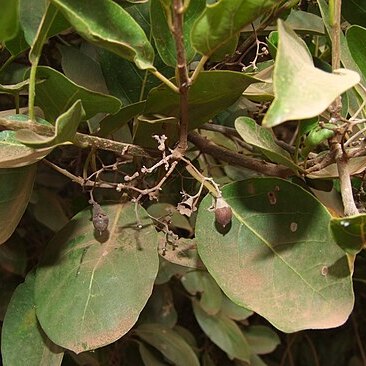Male flowers with buds c. 5 mm. long, obovoid, glabrous or subglabrous but often with a tuft of minute hairs at the apex; calyx 5–6 mm. long, tubular-campanulate, irregularly 3–5-toothed, membranous, glabrous or subglabrous outside, minutely strigose inside; corolla whitish, with tube 3.5–5.0 mm. long, cylindric, glabrous outside and inside save by a few hairs on the line of the stamens and with 4–5 lobes, 4.5–5.5 x 1.4–1.6 mm., oblong-lanceolate, acute to obtuse, ± reflexed, glabrous; stamens 4–5, inserted at the corolla-throat, filaments 3.5–5.0 mm. long, slender, hairy to the base, anthers 1.5–2.0 mm. long; ovary vestigial without style.
Female flowers with buds as in male flowers; calyx 4.5–5.5 mm. long, campanulate to cylindrical, thickened at base, indumentum as in male flowers; corolla as in male flowers; staminodes 4–5, filaments 1.5–2.5 mm. long, sterile anthers 0.8–1.0 mm. long; ovary c. 2 mm. long, ± ellipsoid, glabrous; style 6.5–7.5 mm. long, first forked at 2.0–2.5 mm. and with stigmatic branches 3.0–4.0 mm. long, linear, lobed.
Leaves alternate; petiole 0.8–3.0(4.0) cm. long, canaliculate, glabrous; lamina 5–12 x 2.5–7.0 cm., elliptic or broadly elliptic to obovate, glabrous on the mature leaves, acute to obtuse at apex, cuneate to truncate and often asymmetrical at base, with entire margins, membranous to almost coriaceous, with 5–7 secondary nerves on each side of the midrib, not conspicuous on the lower surface, reticulate.
Small tree up to 8(10) m. high or sometimes a scandent shrub, dioecious, with hard timber; trunk and branches irregularly fluted, often square in section and even buttressed; bark smooth, grey-green in small specimens, becoming blue-grey and peeling away into thin plate-like flakes; branchlets glabrous, very rarely hairy.
Fruit c. 15 x 10 mm., ovoid-conical, apiculate, glabrous, orange when ripe, surrounded at the base by the enlarged widely campanulate many-toothed calyx; pyrene angular-ovoid, c. 10 x 7 mm., 1-seeded.
Cymes arranged in shortly peduncled, slender, terminal and pseudo-axillary pseudo-dichotomous lax 2.5–6.0 cm. long and 3–9 cm. wide panicles; rhachis and branches glabrous or with scattered hairs.
Flowers male or female, on pedicels up to 2 mm. long.

